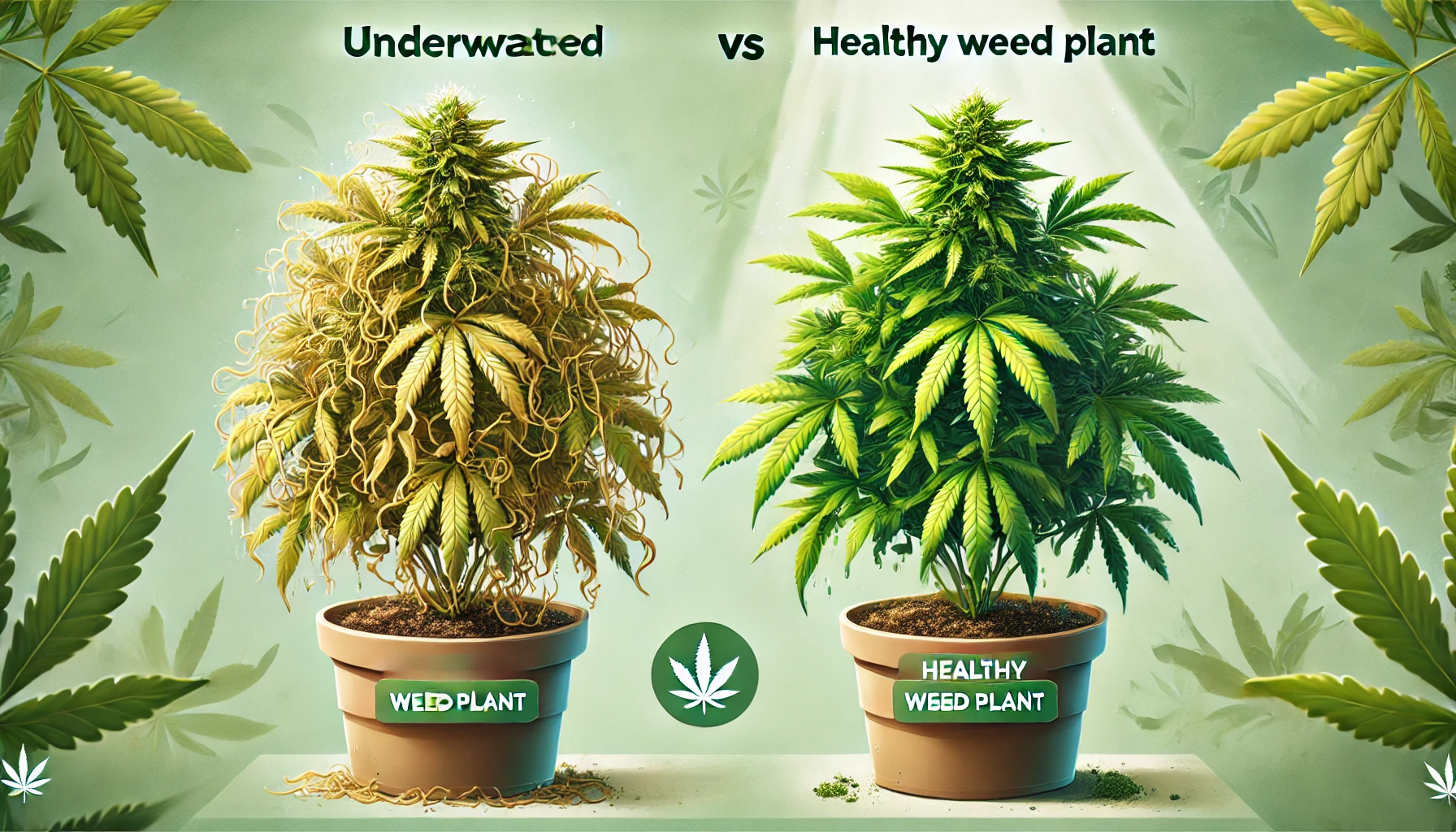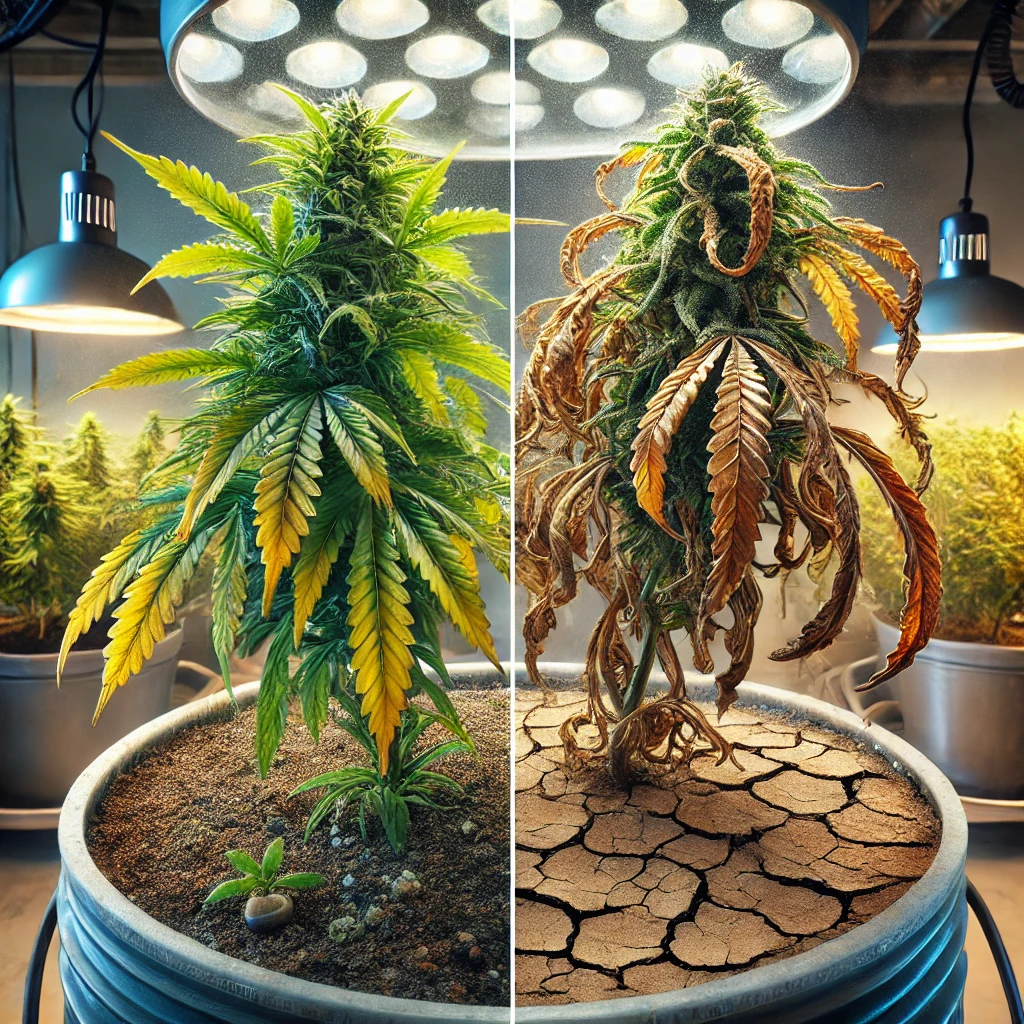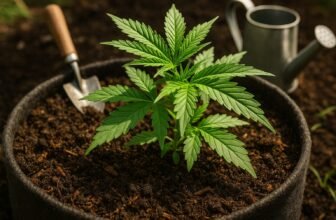
Growing cannabis successfully requires precision—especially when it comes to watering. Underwatered weed plants are a common issue, particularly for new growers who may focus too much on preventing overwatering. However, cannabis plants deprived of sufficient moisture can quickly become stunted, wilted, and less productive. This guide will help you identify signs of underwatering, fix the problem effectively, and prevent it in future grows—whether you’re growing indoors or outdoors.
What Does an Underwatered Weed Plant Look Like?
If your cannabis plant is looking sad, limp, or just off, it might be telling you it’s thirsty. One of the first signs of an underwatered weed plant is drooping leaves—they’ll look wilted, lifeless, and may even curl inward as the plant tries to conserve moisture. Unlike overwatered plants, which feel mushy and soft, underwatered ones tend to feel dry and brittle, especially at the leaf edges.
A quick check of the soil condition can offer more clues. If the topsoil is dry, crusty, and pulling away from the edges of the pot, your plant likely hasn’t had enough water for a while. Cannabis roots need consistent moisture—not soaking wet, but not bone dry either. Cannabis dehydration leads to stem weakness, where the main stalk may look thinner and less upright than usual.
Also, look for faded or dull leaf color. Healthy weed plants have a rich, vibrant green tone. When underwatered, the leaves may appear pale or develop brown tips and edges, especially in younger plants or seedlings.
Remember, an underwatered cannabis plant isn’t doomed—it’s just stressed. Spotting these signs early gives you a great chance to revive your dry weed plant before it impacts growth and yield.

🌱 What Happens When Weed Plants Are Underwatered?
When cannabis plants don’t receive enough water, they can’t transport nutrients through their vascular system. This leads to wilting, drooping leaves, and stunted growth. Root zones dry out, microbial life dies off, and photosynthesis slows down, which ultimately affects yields and bud quality.
Common Causes of Underwatering in Cannabis Plants
Underwatering might seem like a simple mistake, but the causes often run deeper than just “not enough water.” One of the most common reasons is an inconsistent watering schedule. New growers sometimes assume cannabis needs less water than it actually does, especially during hot days or early vegetative growth. But in reality, weed plants have specific water needs based on their size, environment, and container type.
Another major culprit? Fast-draining soil or improper soil mix. If you’re using a growing medium that doesn’t retain moisture well—like pure coco coir without amendments or sandy outdoor soil—your plant’s roots can dry out quickly, even if you water regularly. That leads to root dehydration, stunted growth, and nutrient lockout.
Pot size also matters more than most think. A tiny pot for a large plant can dry out within hours, especially under high-intensity lights or direct sunlight. Without enough room for roots to spread and store moisture, your cannabis is constantly battling water stress.
Let’s not forget the environment. If your grow room or outdoor spot has low humidity, strong airflow, or high temperatures, the plant will transpire more and lose water faster. Without adjusting your watering accordingly, even a well-timed schedule can fall short.
In short, underwatering usually happens when watering habits don’t match your plant’s environment, soil, or growth stage. Once you understand these common causes, it’s much easier to build a routine that keeps your cannabis hydrated and thriving.
🚩 Signs of Underwatered Weed Plants
Recognizing the symptoms early can save your plant. Watch out for these semantic signs of cannabis dehydration:
- Drooping leaves that feel dry and crispy
- Pale or yellowing foliage, especially near the base
- Soil pulling away from the edges of the pot
- Slow growth rate, even in strong lighting
- Lightweight pots when lifted
These symptoms may resemble nutrient deficiencies or heat stress, but dry root zones are a dead giveaway that your cannabis plant is underwatered.
How to Revive an Underwatered Cannabis Plant
Don’t panic—reviving an underwatered cannabis plant is very doable if you catch it in time. First things first: avoid the urge to drench the plant all at once. That might shock the roots. Instead, reintroduce moisture gradually and evenly to help your plant bounce back without added stress.
Start by checking the soil moisture level about an inch or two down. If it’s bone dry, begin with a slow, deep watering. Pour a bit of water slowly around the base, give it time to soak in, then repeat until you see water start to drip from the drainage holes. This ensures water reaches the root zone without just running off dry soil.
Using room-temperature water is key. Cold water can stress the roots, and hot water is obviously harmful. If you’re growing in containers, elevate them slightly to allow full drainage and avoid any water pooling underneath. For really dry soil, you can mix in a wetting agent or a bit of aloe vera water to help with absorption.
After rehydrating, give your plant time. Within a few hours to a day, drooping cannabis leaves should start perking up. Don’t rush to feed it right away—wait until the plant shows signs of recovery before resuming your normal nutrient schedule.
To help the roots recover fully, maintain a stable environment: moderate temps, proper air circulation, and some shade if growing outdoors. Within a day or two, your plant should regain strength, signaling a successful recovery from dehydration.
✅ How to Fix an Underwatered Cannabis Plant
Here’s how to revive a thirsty cannabis plant step by step:
- Rehydrate gradually – Avoid drenching dry soil all at once. Instead, water in small increments, allowing the soil to absorb moisture evenly.
- Use room-temperature water – Cold water can shock the roots. Aim for 20–22°C (68–72°F).
- Check runoff – Ensure water reaches the root zone without pooling or running off the sides.
- Monitor recovery – Within hours, leaves should begin to perk up. Full recovery may take a day or two.
- Top-dress with compost or worm castings – This improves soil water retention and microbial health.

Long-Term Effects of Chronic Underwatering
If underwatering happens once or twice, your cannabis plant can usually bounce back. But if it’s a chronic issue, the long-term effects can seriously hurt your harvest. When a weed plant doesn’t get enough water over time, it enters survival mode—slowing down growth, halting nutrient uptake, and producing fewer, smaller buds.
One major consequence is stunted growth. Without proper hydration, cells can’t expand, and the plant becomes short, weak, and thin. You might also notice the root system shrinking or staying shallow, which makes it even harder for the plant to access nutrients and water in the future.
Another issue is bud development problems. Cannabis plants need water to move nutrients and support flowering. When they’re dehydrated during the flowering stage, the buds often turn out airy, loose, and low in potency.
And don’t overlook leaf discoloration—yellowing, crispy tips, and premature leaf drop are signs of ongoing plant stress. These symptoms can easily be mistaken for nutrient deficiencies, but the root cause is often dehydration.
In the worst cases, repeated underwatering can lead to permanent root damage, especially in young plants or seedlings. Once the roots start to die off, recovery becomes much harder—sometimes impossible. That’s why it’s so important to address underwatering before it becomes a habit.

🧪 Best Soil for Moisture Retention
Choosing the right cannabis soil mix can make a big difference in preventing underwatering. Look for soil that balances drainage and water-holding capacity.
Recommended components for healthy cannabis soil:
- Coco coir or peat moss – retains moisture without becoming soggy
- Perlite or pumice – improves drainage and root aeration
- Compost or worm castings – holds nutrients and microbial life
- Mycorrhizal fungi – promotes root development and moisture uptake
Pre-mixed organic cannabis soils like FoxFarm Ocean Forest or Pro-Mix HP are excellent options.
Best Watering Practices to Prevent Underwatering
The best way to prevent underwatered weed plants is by creating a consistent watering routine tailored to your growing setup. That means understanding your plant’s environment, pot size, and growth stage—not just guessing when it looks thirsty.
Start with the finger test or a moisture meter to check the soil. If the top inch feels dry, it’s probably time to water. Don’t just rely on a calendar schedule—conditions like temperature, humidity, and airflow all affect how quickly your medium dries out.
Use breathable containers, like fabric pots, which allow better airflow and root oxygenation. They also help you avoid both overwatering and underwatering by improving drainage. Make sure your pots have adequate drainage holes to keep water from pooling at the bottom, which can harm roots in other ways.
When watering, go slow and deep. You want moisture to reach the entire root zone, not just the surface. Pour water evenly around the base of the plant and stop once you see it lightly draining out the bottom. Let the soil dry slightly before the next watering, but don’t let it become bone dry. This balance is key to prevent cannabis dehydration.
Also, adjust your watering based on growth stage. Seedlings need less water but more frequent attention, while mature flowering plants drink more and need deeper watering. Keep an eye on environmental factors—outdoor grows in hot or windy areas may need more frequent watering than indoor plants in stable conditions.
In short, knowing your plant’s needs and observing how quickly the soil dries will help you avoid the stress and setbacks of underwatering—leading to healthier roots, stronger growth, and better yields.
💡 Lighting Needs and Water Consumption
Cannabis lighting intensity directly affects water needs. Plants under strong grow lights or full sun will transpire more, requiring more frequent watering.
- Indoor growers using LED or HPS lights should monitor soil moisture daily.
- Outdoor growers must factor in wind, sunlight, and temperature fluctuations.
- Use mulch in outdoor grows to retain moisture and stabilize temperature.
Pro tip: Use a soil moisture meter or the “finger test” (stick your finger 1–2 inches into the soil) to determine if watering is needed.
❌ Common Watering Mistakes to Avoid
Many growers swing between underwatering and overwatering. Here’s what to watch out for:
- Inconsistent watering schedule – Letting plants dry out too much before watering again
- Using compacted or hydrophobic soil – Water runs off instead of absorbing
- Poor drainage – Water accumulates at the bottom, rotting roots
- Over-reliance on automatic irrigation systems – These can malfunction or misjudge environmental needs
Creating a balanced watering routine based on pot size, temperature, and plant size is key to consistent growth.
🛡️ Prevention Tips for Underwatering
To avoid dehydration in your cannabis garden:
- Use fabric pots or air pots to enhance root oxygenation and moisture regulation
- Add vermiculite or biochar to retain moisture in the soil
- Water slowly and evenly until slight runoff is visible
- Observe plant posture daily—drooping may signal an issue
- Install automated soil moisture sensors for precision irrigation
Keeping a grow journal can also help track watering habits, light intensity, and humidity changes that affect your plant’s needs.
Related Issues: Underwatering vs Nutrient Deficiency
It’s easy to confuse the symptoms of underwatering with those of a nutrient deficiency, especially when your cannabis leaves start turning yellow, curling, or drying out. But understanding the difference is key to fixing the right problem without making things worse.
When your plant is underwatered, the soil will usually be dry and crumbly, and the leaves will look wilted, often with crispy edges. You may also notice that the entire plant seems to sag, and the growth rate slows down noticeably. The fix here is moisture—your plant is experiencing water stress, not a lack of nutrients.
In contrast, a nutrient deficiency usually shows up in more targeted ways. For example, nitrogen deficiency starts with yellowing of lower leaves, while a magnesium deficiency might cause interveinal yellowing or red stems. In most cases, the soil moisture feels normal, and the plant doesn’t droop like it does when dehydrated.
One smart move is to test your soil pH and moisture. Cannabis struggles to absorb nutrients if the pH is off, which can mimic deficiency signs. But if the soil is bone dry and the pot feels light, you’re likely looking at root dehydration, not nutrient lockout.
It’s also important not to overcompensate. If your plant is underwatered and you start feeding it extra nutrients, it can’t absorb them properly—potentially causing fertilizer burn on top of the original problem.
The takeaway? Always check soil moisture, plant posture, and the pattern of leaf discoloration before assuming it’s a nutrient issue. This helps you accurately diagnose whether you’re dealing with cannabis dehydration or a true nutrient imbalance—and treat your plant accordingly.
FAQs
There’s no one-size-fits-all schedule. The right watering frequency depends on your plant’s size, stage of growth, pot size, and environment. Generally, water when the top inch of soil feels dry, or use a moisture meter for more precision. Cannabis in hot, dry climates or under strong grow lights will need more frequent watering to prevent dehydration.
Yes—if caught early, drooping cannabis leaves will perk back up within hours of a proper watering. The key is to rehydrate the soil slowly and avoid shocking the roots. However, if the leaves have turned crispy or brown at the edges, they may not fully bounce back, even if the plant survives.
Look for wilting, dry soil, and leaf curling. The entire plant may look “sad,” with soft stems and dull or pale leaves. Cannabis dehydration starts subtly but progresses fast, so catching these early cues helps prevent root stress and stunted growth.
Check the soil! Underwatered soil is light, dusty, and pulls away from the pot’s edge. Leaves droop but feel dry and papery. With overwatering, the soil is soggy, and leaves droop too—but they feel soft and sometimes swollen. Recognizing this difference is essential to treating your cannabis properly.
The quickest fix is a slow, deep watering. Pour water gradually until the root zone is fully moist, and allow the plant to absorb it without flooding. For extreme dryness, repeat the process after a few minutes to ensure the soil rehydrates evenly. Keep the environment stable while the plant recovers.
📝 Final Thoughts
Underwatered cannabis plants are recoverable if caught early—but prevention is always better than cure. Use moisture-retentive soil, monitor your plants daily, and water consistently. With a solid watering routine, your weed plants will thrive from seedling to harvest.
Related Reading: Keep Your Cannabis Plants Thriving
If you’re tackling underwatering issues, it’s also a great time to take a deeper look at your cannabis growing medium. Soil quality plays a big role in how well your plants retain moisture and access nutrients.
Check out our full guide on the best soil for growing cannabis to learn which mixes promote proper water retention, drainage, and root health—key factors in preventing both underwatering and overwatering.
And if you’re just starting out with young plants, don’t miss our post on how to water cannabis seedlings. It covers gentle techniques and watering tips tailored for the seedling stage, when plants are most vulnerable to moisture stress and root issues.
🔗 Related: Growing Weed Outdoors – Complete Beginner’s Guide
If you’re growing outdoors and struggling with watering, check out our complete guide to outdoor cannabis cultivation. Learn how to maximize yield, choose the right strains, and create an efficient irrigation setup.






